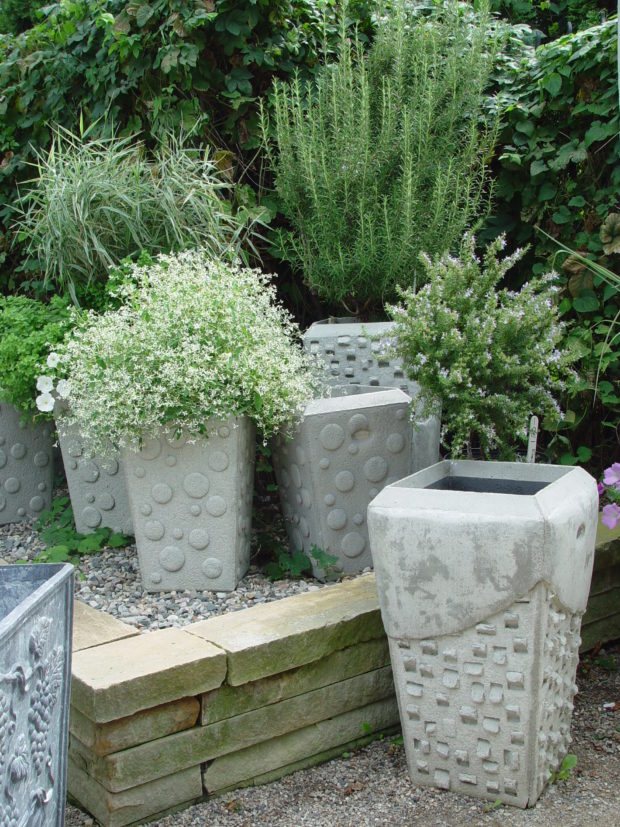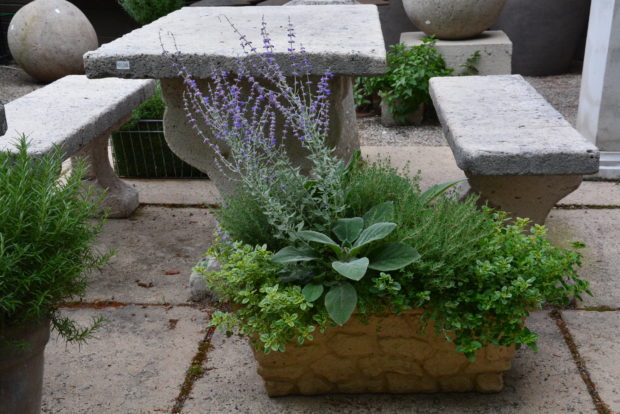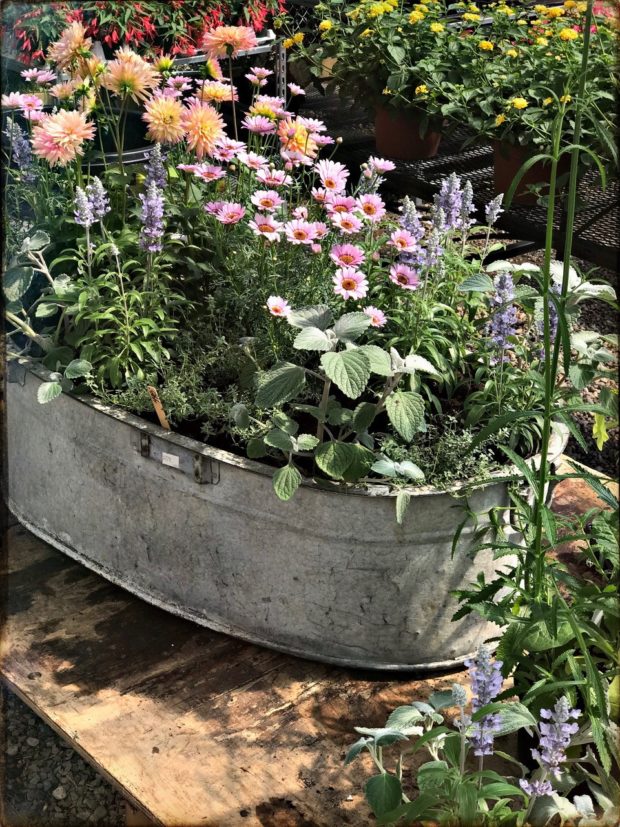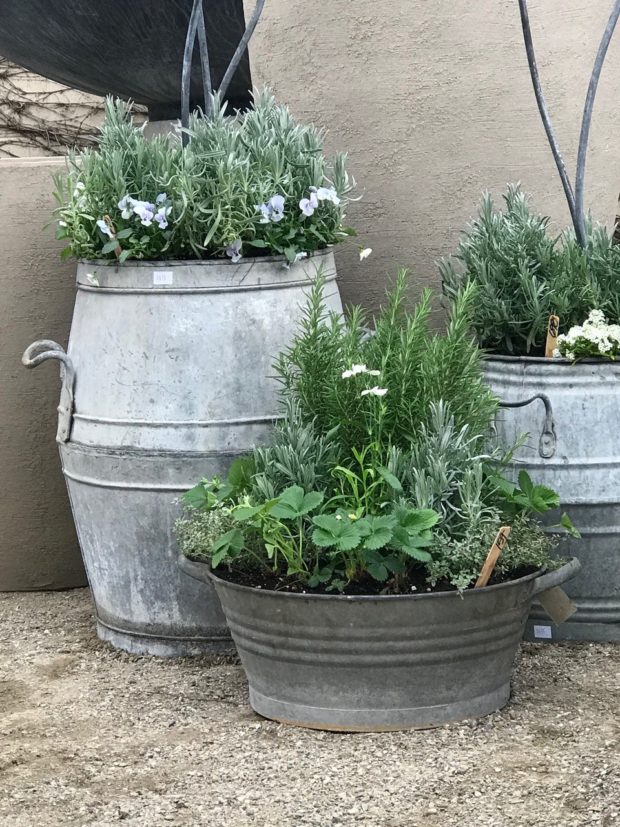 Rob has planted so many herb/flower and vegetable pots-to follow is a big selection that compliments my last post.
Rob has planted so many herb/flower and vegetable pots-to follow is a big selection that compliments my last post.
Archives for May 2020
At A Glance: In The Same Genre
Sustaining
My apologies to all of you who read my essays. Two days ago, the server for all of our associated websites and this blog crashed. All is rebuilt now, but my latest post, this post named “Sustaining” was a casualty, but for the beginning two paragraphs. The original version cannot be restored. To follow is a rewriting of that post. For those of you that were able to read before the crash, I hope this version will be tolerable, or better. For those of you seeing it for the first time, this is the first in a series I hope to write about planting containers for the garden. It’s that time.
 The instinct to sustain comes standard issue with all living things. Animals strengthen and support their newborn young with mother’s milk, a home, and protection from danger of all sorts. That Mom supplies her young with all of the necessities of life, whether it comes from her, or from a source of water, shelter or food nearby. Some parents with no innate directive to protect or feed their young produce progeny by the hundreds or thousands. Sustenance comes in a lot of different forms. People, those most complex of all the creatures, do much the same, but in a more complex and individual way. Luckily, many kids lacking sustenance emerge with a will to grow, standard issue. Some seed within them grows. What is truly amazing is how many varied paths of affirmation work. Astonishing, this. Plants likewise have mechanisms to not only grow, but protect their own survival for generations to come. Even the most cursory study of seeds, and the conditions under which they germinate and grow, makes it clear that the urge to survive is a most basic tenet of life. The flowers have a grand purpose. Pollination and the the eventual production of seed insures the survival of the species. Those of us who treasure flowers whenever they appear are witnessing the story of how a species is sustained from one generation to the next – every bit as much as their ephemeral beauty.
The instinct to sustain comes standard issue with all living things. Animals strengthen and support their newborn young with mother’s milk, a home, and protection from danger of all sorts. That Mom supplies her young with all of the necessities of life, whether it comes from her, or from a source of water, shelter or food nearby. Some parents with no innate directive to protect or feed their young produce progeny by the hundreds or thousands. Sustenance comes in a lot of different forms. People, those most complex of all the creatures, do much the same, but in a more complex and individual way. Luckily, many kids lacking sustenance emerge with a will to grow, standard issue. Some seed within them grows. What is truly amazing is how many varied paths of affirmation work. Astonishing, this. Plants likewise have mechanisms to not only grow, but protect their own survival for generations to come. Even the most cursory study of seeds, and the conditions under which they germinate and grow, makes it clear that the urge to survive is a most basic tenet of life. The flowers have a grand purpose. Pollination and the the eventual production of seed insures the survival of the species. Those of us who treasure flowers whenever they appear are witnessing the story of how a species is sustained from one generation to the next – every bit as much as their ephemeral beauty.
 Anyone who gardens has that instinct to nourish and nurture. That comes part and parcel with the urge to try to make something grow. The effort it takes to grow and sustain a landscape and garden is considerable. Aching backs, permanently dirty nails and sunburned noses, scrapes scratches, bruises, frustrations and failures tell the story. All that effort in search of that perfect moment. The gardener enjoying the garden they create and sustain. The natural world is a world in which every living thing jostles for space, breathes, and prospers, or not. The outcomes are not always predictable or positive. Every living thing is as capable of sustaining injury or damage as they Anyone who gardens has seen treasured plants demolished by deer, or destroyed by an exceptionally hostile winter. The list of the plants that have died on my watch is a very long list. Those plants that have persisted are a source of great joy. Life and death in the garden is pure theater. Why else would gardeners come back for more, year after year? The spring season is anticipated for months, and the experience of watching plants break dormancy and grow is an experience like no other.
Anyone who gardens has that instinct to nourish and nurture. That comes part and parcel with the urge to try to make something grow. The effort it takes to grow and sustain a landscape and garden is considerable. Aching backs, permanently dirty nails and sunburned noses, scrapes scratches, bruises, frustrations and failures tell the story. All that effort in search of that perfect moment. The gardener enjoying the garden they create and sustain. The natural world is a world in which every living thing jostles for space, breathes, and prospers, or not. The outcomes are not always predictable or positive. Every living thing is as capable of sustaining injury or damage as they Anyone who gardens has seen treasured plants demolished by deer, or destroyed by an exceptionally hostile winter. The list of the plants that have died on my watch is a very long list. Those plants that have persisted are a source of great joy. Life and death in the garden is pure theater. Why else would gardeners come back for more, year after year? The spring season is anticipated for months, and the experience of watching plants break dormancy and grow is an experience like no other.
 Gardeners of all description are in the full swing of it now. All because the relationship people forge with nature is sustaining. There are landscapes and gardens being cleaned up. There are new plants going in the ground. There are plans for a new terrace, or a fountain. Some older landscapes are getting a refresh. A garden bench is getting a fresh coat of paint. I for one have always enjoyed weeding; its solitary and contemplative byproduct is a tonic. Pulling weeds does not require much in the way of concentration, so there is time to hear the birds. In a frantic world, the garden is other worldly, and restorative. That spring move into the garden is the emotional equivalent of a trip to the cottage or the beach without any travel time involved. We mark the beginning of the summer gardening season by planting containers. It’s a specialty of the house.
Gardeners of all description are in the full swing of it now. All because the relationship people forge with nature is sustaining. There are landscapes and gardens being cleaned up. There are new plants going in the ground. There are plans for a new terrace, or a fountain. Some older landscapes are getting a refresh. A garden bench is getting a fresh coat of paint. I for one have always enjoyed weeding; its solitary and contemplative byproduct is a tonic. Pulling weeds does not require much in the way of concentration, so there is time to hear the birds. In a frantic world, the garden is other worldly, and restorative. That spring move into the garden is the emotional equivalent of a trip to the cottage or the beach without any travel time involved. We mark the beginning of the summer gardening season by planting containers. It’s a specialty of the house.
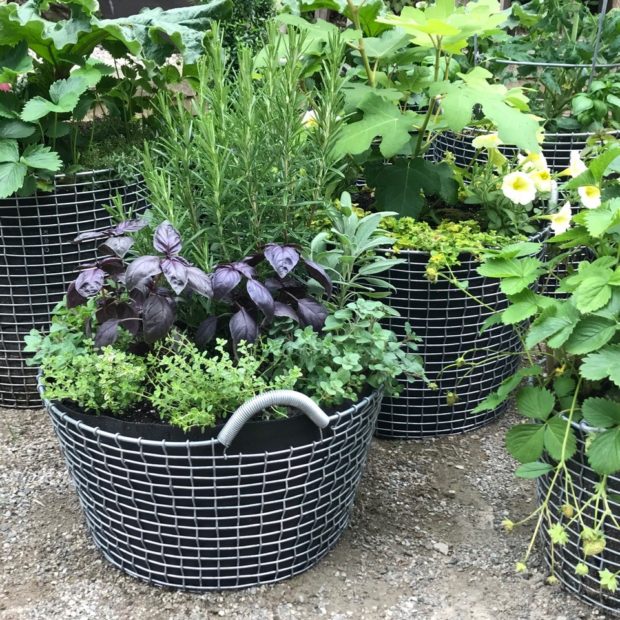 Rob plants containers in May in his own inimitable and sustaining style. He puts up planters that combine herbs, vegetables and flowers in a relaxed and graceful way. His plantings strongly evoke the agricultural roots of all gardening. Planting crops that feed communities is life sustaining. A place for growing vegetables and herbs in the garden takes many forms. Some gardeners plant ornamental plants incidental to a working garden. Others want a few tomatoes and some herbs to cook with. No matter the form or extent, growing those plants that sustain life sustains a very basic emotional need – a working connection to nature of which we are all a part. Rob is apt to purchase lots of containers that compliment these first container plantings. Baskets of all shapes and styles, wood boxes and crates, galvanized buckets and tubs all speak to the farm garden. Even the contemporary stainless steel wire baskets with fabric liners pictured above pair remarkably well with a planting of herbs.
Rob plants containers in May in his own inimitable and sustaining style. He puts up planters that combine herbs, vegetables and flowers in a relaxed and graceful way. His plantings strongly evoke the agricultural roots of all gardening. Planting crops that feed communities is life sustaining. A place for growing vegetables and herbs in the garden takes many forms. Some gardeners plant ornamental plants incidental to a working garden. Others want a few tomatoes and some herbs to cook with. No matter the form or extent, growing those plants that sustain life sustains a very basic emotional need – a working connection to nature of which we are all a part. Rob is apt to purchase lots of containers that compliment these first container plantings. Baskets of all shapes and styles, wood boxes and crates, galvanized buckets and tubs all speak to the farm garden. Even the contemporary stainless steel wire baskets with fabric liners pictured above pair remarkably well with a planting of herbs.
 The herb pots come first for a simple reason. They not only whet the appetite for the summer season to come, many herbs – basil excepted – are quite tolerant of unpredictably chilly spring weather. The pot pictured above is planted with a couple miniature petunias. They shrug off cold weather as well. The plastic liner in the reed baskets help improve their longevity.
The herb pots come first for a simple reason. They not only whet the appetite for the summer season to come, many herbs – basil excepted – are quite tolerant of unpredictably chilly spring weather. The pot pictured above is planted with a couple miniature petunias. They shrug off cold weather as well. The plastic liner in the reed baskets help improve their longevity.
 vintage berry baskets planted with rosemary, variegated scented geraniums and anbual phlox
vintage berry baskets planted with rosemary, variegated scented geraniums and anbual phlox
 Will the grapes produced by this grapevine be sufficient for a few bottles of home made wine, or jars of marmalade? No. But planted up in a vintage champagne grape crate, this container planting is earthy in every regard.
Will the grapes produced by this grapevine be sufficient for a few bottles of home made wine, or jars of marmalade? No. But planted up in a vintage champagne grape crate, this container planting is earthy in every regard.
 Mint is an impossible thug in the garden. It will run everywhere, and is very difficult to eradicate or control. But a planting in a bucket means this fragrant herb is available for seasoning lamb or as a garnish in a summer drink.
Mint is an impossible thug in the garden. It will run everywhere, and is very difficult to eradicate or control. But a planting in a bucket means this fragrant herb is available for seasoning lamb or as a garnish in a summer drink.
 Topiary plant forms have long been a mainstay of the formal garden. The tin pots Rob chose for them recall that history. These lavender and scented geraniums on standard are a more cottage garden version that pair will with pots of herbs and flowers. These are under planted with alyssum and lavender bacopa.
Topiary plant forms have long been a mainstay of the formal garden. The tin pots Rob chose for them recall that history. These lavender and scented geraniums on standard are a more cottage garden version that pair will with pots of herbs and flowers. These are under planted with alyssum and lavender bacopa.
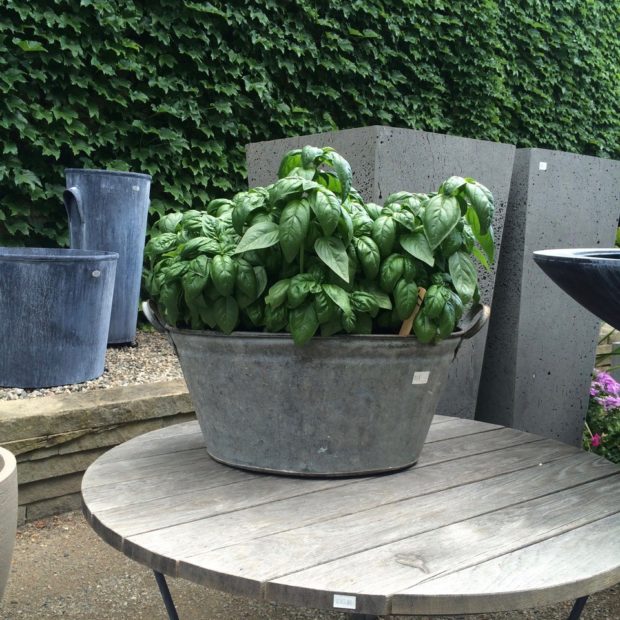 vintage oval bucket filled with basil
vintage oval bucket filled with basil
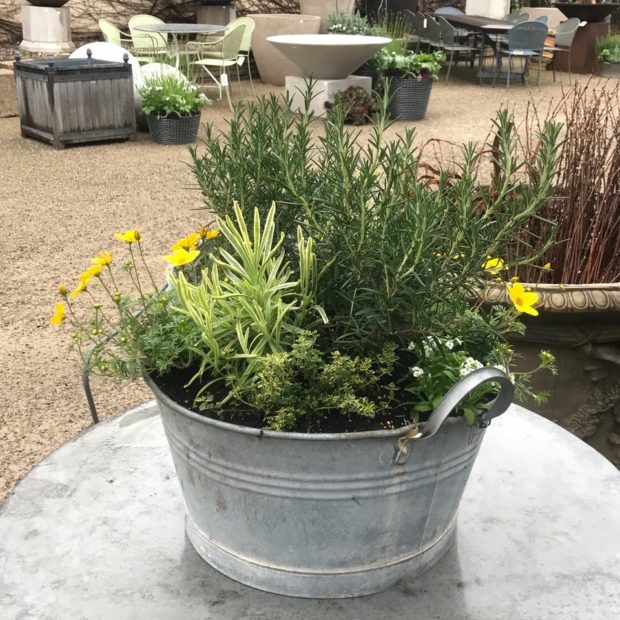 rosemary, variegated lavender, bidens, variegated thyme and alyssum
rosemary, variegated lavender, bidens, variegated thyme and alyssum
 tomato under planted with gold oregano and thyme
tomato under planted with gold oregano and thyme
 a collection of associated vintage and new pots
a collection of associated vintage and new pots
 Chicago figs and yellow petunias
Chicago figs and yellow petunias
 tomatoes and herbs planted in terra cotta long toms.
tomatoes and herbs planted in terra cotta long toms.
 handled bucket with strawberries, thyme, and white dianthus
handled bucket with strawberries, thyme, and white dianthus
 Rob planted The Fed in Clarkston with loads of lavender and herbs last year. He will be doing it again this year. These pots hit all the right notes, don’t they?
Rob planted The Fed in Clarkston with loads of lavender and herbs last year. He will be doing it again this year. These pots hit all the right notes, don’t they?
Sheared: Part Two
 Anyone who chooses to look up topiary plants of distinction on their computer will find no end of articles with pictures of grand gardens featuring breathtaking topiary plants. Many of them have been cultivated long enough to have acquired shrine status. The size and scale of many of these topiary plants is staggering, never mind the work that is involved in keeping them up. I enjoy seeing them as much as the next person. But I also have great admiration for gardeners who on a more personal scale grow on plants that require a substantial and steady commitment to the maintenance. The single ball boxwood topiaries that are pictured above began as fairly modest plants grown at a farm specializing in boxwood in the Pacific Northwest. My memory is of a head diameter of perhaps 10 or 12 inches. The trunk would have been in the neighborhood of a quarter to a one half inch caliper. When these topiaries arrived, their trunks were secured to bamboo stakes virtually identical in size to the trunk, and as tall as the the stem and head. This is smart staking. The head of a topiary is the most vulnerable to catching the wind, and snapping off. Young topiaries are fragile. If you expect to grow them on, protect every part of them, bottom to the very top. I can’t say exactly how long we wintered these trees for my client, but it may have been 8 years or so. They summered in pots, and wintered in our unheated garage space. We were taking no chances with winter weather. Did we do the yearly pruning? No. We farmed that job out to an expert.
Anyone who chooses to look up topiary plants of distinction on their computer will find no end of articles with pictures of grand gardens featuring breathtaking topiary plants. Many of them have been cultivated long enough to have acquired shrine status. The size and scale of many of these topiary plants is staggering, never mind the work that is involved in keeping them up. I enjoy seeing them as much as the next person. But I also have great admiration for gardeners who on a more personal scale grow on plants that require a substantial and steady commitment to the maintenance. The single ball boxwood topiaries that are pictured above began as fairly modest plants grown at a farm specializing in boxwood in the Pacific Northwest. My memory is of a head diameter of perhaps 10 or 12 inches. The trunk would have been in the neighborhood of a quarter to a one half inch caliper. When these topiaries arrived, their trunks were secured to bamboo stakes virtually identical in size to the trunk, and as tall as the the stem and head. This is smart staking. The head of a topiary is the most vulnerable to catching the wind, and snapping off. Young topiaries are fragile. If you expect to grow them on, protect every part of them, bottom to the very top. I can’t say exactly how long we wintered these trees for my client, but it may have been 8 years or so. They summered in pots, and wintered in our unheated garage space. We were taking no chances with winter weather. Did we do the yearly pruning? No. We farmed that job out to an expert.
 These topiary starts of lemon cypress- cupressus macrocarpa Goldcrest “Wilma” will top out at 3 feet or so. Outdoors, in a zone 7 or warmer, Goldcrest can grow to 16′ tall or so. The dwarf version Wilma makes a good house plants, provided they have a really sunny south facing location for at least 4 hours a day over the winter. They like cool temperatures, so wintering them over in a house kept at 72 degrees can be a tough go. Like most cypress, they appreciate evenly moist soil. If you let the rootball dry out, you have lost the plant. It is the juvenile foliage that has the best lime green color, so regular trimming will preserve that color. They appreciate a summer outdoors, but I try for a full sun morning with a little protection from the worst of the afternoon sun. Be advised that each stem you trim will probably turn brown at the cut. But once that branch starts growing again, that cut mark will fade from view. This is a quick look at the care issues with lemon cypress. Should you have the idea to grow them, look up their culture on line, and read.
These topiary starts of lemon cypress- cupressus macrocarpa Goldcrest “Wilma” will top out at 3 feet or so. Outdoors, in a zone 7 or warmer, Goldcrest can grow to 16′ tall or so. The dwarf version Wilma makes a good house plants, provided they have a really sunny south facing location for at least 4 hours a day over the winter. They like cool temperatures, so wintering them over in a house kept at 72 degrees can be a tough go. Like most cypress, they appreciate evenly moist soil. If you let the rootball dry out, you have lost the plant. It is the juvenile foliage that has the best lime green color, so regular trimming will preserve that color. They appreciate a summer outdoors, but I try for a full sun morning with a little protection from the worst of the afternoon sun. Be advised that each stem you trim will probably turn brown at the cut. But once that branch starts growing again, that cut mark will fade from view. This is a quick look at the care issues with lemon cypress. Should you have the idea to grow them, look up their culture on line, and read.
 No topiary in our zone is more challenging to grow than a myrtle. Myrtis communis compacta is an evergreen shrub that is especially genial and tolerant of frequent pruning. What they are not tolerant of is dry soil. During the winter, they need bright light, and even moisture. Myrtle topiaries of the scale and size pictured above requires a passionate and faithful grower. I have not seen myrtle topiaries of this size and scale very often, but I can attest that these clients lavished no end of attention on them.
No topiary in our zone is more challenging to grow than a myrtle. Myrtis communis compacta is an evergreen shrub that is especially genial and tolerant of frequent pruning. What they are not tolerant of is dry soil. During the winter, they need bright light, and even moisture. Myrtle topiaries of the scale and size pictured above requires a passionate and faithful grower. I have not seen myrtle topiaries of this size and scale very often, but I can attest that these clients lavished no end of attention on them.
 Certain trees are quite tolerant of close pruning. The carpinus pictured above has been expertly trimmed by a virtuoso with shears. I am quite sure there was a lift involved. They respond enthusiastically to pruning. This sheared shape is close to the natural shape of the tree, meaning the health of the tree is not endangered. A tree is a vast subject for a topiary, but the time between prunings can be fairly long. Linden trees are equally amicable about this kind of pruning. The boxed lindens on the driveway at Detroit Garden Works are pruned every other year at most.
Certain trees are quite tolerant of close pruning. The carpinus pictured above has been expertly trimmed by a virtuoso with shears. I am quite sure there was a lift involved. They respond enthusiastically to pruning. This sheared shape is close to the natural shape of the tree, meaning the health of the tree is not endangered. A tree is a vast subject for a topiary, but the time between prunings can be fairly long. Linden trees are equally amicable about this kind of pruning. The boxed lindens on the driveway at Detroit Garden Works are pruned every other year at most.
 Limelight hydrangeas make gorgeous single ball topiary plants. The loosely spherical head in full flower is quite spectacular. As hydrangeas are naturally very coarse growing plants, their shape is a study in contradictions. They are informally formal. Our grower trims the hydrangea standards twice a season. Once in late March or early April, and again later in May. This schedule helps to produce a strong network of branches that helps keep the flower heads aloft. Even so, we often tie up the branches with stretch tie, to make sure the framework is strong. The stake is as tall as the very top of the plant.
Limelight hydrangeas make gorgeous single ball topiary plants. The loosely spherical head in full flower is quite spectacular. As hydrangeas are naturally very coarse growing plants, their shape is a study in contradictions. They are informally formal. Our grower trims the hydrangea standards twice a season. Once in late March or early April, and again later in May. This schedule helps to produce a strong network of branches that helps keep the flower heads aloft. Even so, we often tie up the branches with stretch tie, to make sure the framework is strong. The stake is as tall as the very top of the plant.
 Italian cypress is not hardy in our zone-how I regret that. But if a client is willing to winter them over in an unheated greenhouse they can provide a dramatic focal point to a container for a number of years. This evergreen is naturally very narrow and conical, so the pruning required to keep them tight is a matter of emphasizing and more clearly defining what is already there.
Italian cypress is not hardy in our zone-how I regret that. But if a client is willing to winter them over in an unheated greenhouse they can provide a dramatic focal point to a container for a number of years. This evergreen is naturally very narrow and conical, so the pruning required to keep them tight is a matter of emphasizing and more clearly defining what is already there.
 This young boxwood topiary is delightfully under scaled for its under planting. The boxwood head has not been sheared, but left to its natural devices. It gives a very traditional landscape form a much more contemporary look.
This young boxwood topiary is delightfully under scaled for its under planting. The boxwood head has not been sheared, but left to its natural devices. It gives a very traditional landscape form a much more contemporary look.
 Yews make good topiary subjects, although they do not respond as well to close shearing. This double ball taxus lived for 4 years in this pot, all year round, before succumbing to a particularly cold winter. A little looser treatment produces a better looking plant. As in green through and through. Drastically sheared yews are common in the landscape, but the development of a topiary form is not a goal. It is a once a year effort to exert control over a plant that may be poorly sited. Improperly sheared yews sporting a thin skin of green, and bare branches and trunks underneath is not a good look. It also contributes to the decline and ill-health of the plant.
Yews make good topiary subjects, although they do not respond as well to close shearing. This double ball taxus lived for 4 years in this pot, all year round, before succumbing to a particularly cold winter. A little looser treatment produces a better looking plant. As in green through and through. Drastically sheared yews are common in the landscape, but the development of a topiary form is not a goal. It is a once a year effort to exert control over a plant that may be poorly sited. Improperly sheared yews sporting a thin skin of green, and bare branches and trunks underneath is not a good look. It also contributes to the decline and ill-health of the plant.  Junipers are rough coated evergreens, but they respond surprisingly well to pruning. They are also happy with a long term home in a large container. They are low maintenance shrubs and trees in general, so they shrug off the shearing.
Junipers are rough coated evergreens, but they respond surprisingly well to pruning. They are also happy with a long term home in a large container. They are low maintenance shrubs and trees in general, so they shrug off the shearing.
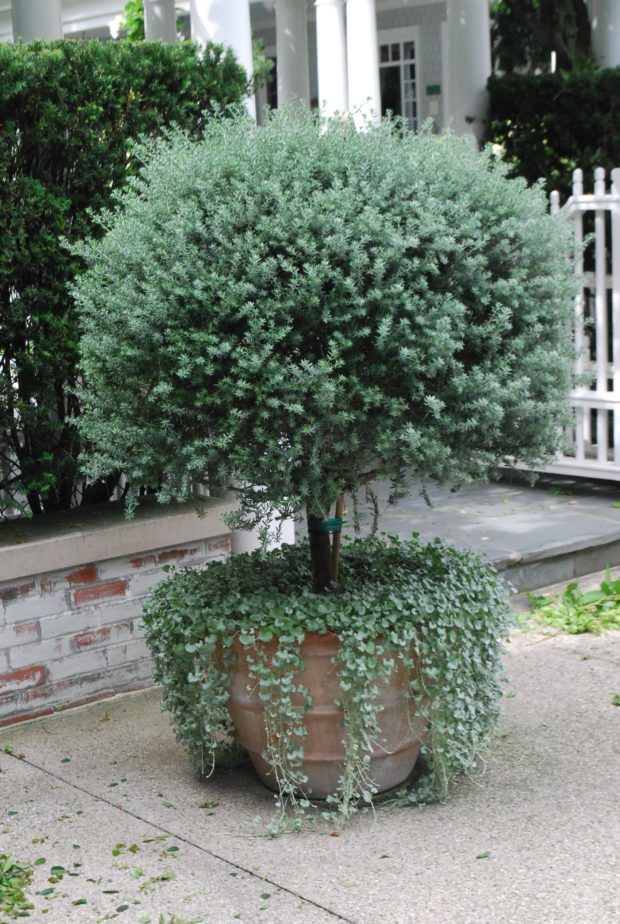 Westringia fructicosa, commonly known as Victorian rosemary, is a dwarf shrub that responds well to development as a topiary. I rarely see it offered for sale, which is unfortunate. This particular single ball topiary made a beautiful container specimen.
Westringia fructicosa, commonly known as Victorian rosemary, is a dwarf shrub that responds well to development as a topiary. I rarely see it offered for sale, which is unfortunate. This particular single ball topiary made a beautiful container specimen.
 Culinary rosemary, or salvia rosemarinus, is a well known subject for topiary. The clippings smell delicious, and its use as an herb is legendary. This particular unsheared topiary is underplanted with fiber optic grass and strawberries.
Culinary rosemary, or salvia rosemarinus, is a well known subject for topiary. The clippings smell delicious, and its use as an herb is legendary. This particular unsheared topiary is underplanted with fiber optic grass and strawberries.
 specimen single ball rosemary on standard
specimen single ball rosemary on standard
 double ball eugenia under planted with begonias
double ball eugenia under planted with begonias
 double ball boxwood topiary under planted with curly parsley
double ball boxwood topiary under planted with curly parsley
variegated Algerian ivy topiary
 unsheared double ball rosemary under planted with lettuce and pansies-perfect for a spring container planting.
unsheared double ball rosemary under planted with lettuce and pansies-perfect for a spring container planting.

